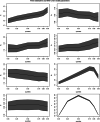Application of quantile mixed-effects model in modeling CD4 count from HIV-infected patients in KwaZulu-Natal South Africa
- PMID: 34983387
- PMCID: PMC8724661
- DOI: 10.1186/s12879-021-06942-7
Application of quantile mixed-effects model in modeling CD4 count from HIV-infected patients in KwaZulu-Natal South Africa
Abstract
Background: The CD4 cell count signifies the health of an individual's immune system. The use of data-driven models enables clinicians to accurately interpret potential information, examine the progression of CD4 count, and deal with patient heterogeneity due to patient-specific effects. Quantile-based regression models can be used to illustrate the entire conditional distribution of an outcome and identify various covariates effects at the respective location.
Methods: This study uses the quantile mixed-effects model that assumes an asymmetric Laplace distribution for the error term. The model also incorporated multiple random effects to consider the correlation among observations. The exact maximum likelihood estimation was implemented using the Stochastic Approximation of the Expectation-Maximization algorithm to estimate the parameters. This study used the Centre of the AIDS Programme of Research in South Africa (CAPRISA) 002 Acute Infection Study data. In this study, the response variable is the longitudinal CD4 count from HIV-infected patients who were initiated on Highly Active Antiretroviral Therapy (HAART), and the explanatory variables are relevant baseline characteristics of the patients.
Results: The analysis obtained robust parameters estimates at various locations of the conditional distribution. For instance, our result showed that baseline BMI (at [Formula: see text] 0.05: [Formula: see text]), baseline viral load (at [Formula: see text] 0.05: [Formula: see text] [Formula: see text]), and post-HAART initiation (at [Formula: see text] 0.05: [Formula: see text]) were major significant factors of CD4 count across fitted quantiles.
Conclusions: CD4 cell recovery in response to post-HAART initiation across all fitted quantile levels was observed. Compared to HIV-infected patients with low viral load levels at baseline, HIV-infected patients enrolled in the treatment with a high viral load level at baseline showed a significant negative effect on CD4 cell counts at upper quantiles. HIV-infected patients registered with high BMI at baseline had improved CD4 cell count after treatment, but physicians should not ignore this group of patients clinically. It is also crucial for physicians to closely monitor patients with a low BMI before and after starting HAART.
Keywords: Asymmetric Laplace distribution; CAPRISA; CD4 count; Quantile mixed model; Quantile regression; Stochastic approximation of the expectation maximization.
© 2021. The Author(s).
Conflict of interest statement
The authors affirm that they have no competing interests, monetary or otherwise.
Figures
Similar articles
-
Additive quantile mixed effects modelling with application to longitudinal CD4 count data.Sci Rep. 2021 Sep 9;11(1):17945. doi: 10.1038/s41598-021-97114-9. Sci Rep. 2021. PMID: 34504147 Free PMC article.
-
Modelling CD4 counts before and after HAART for HIV infected patients in KwaZulu-Natal South Africa.Afr Health Sci. 2020 Dec;20(4):1546-1561. doi: 10.4314/ahs.v20i4.7. Afr Health Sci. 2020. PMID: 34394215 Free PMC article.
-
Treatment with highly active antiretroviral therapy in human immunodeficiency virus type 1-infected children is associated with a sustained effect on growth.Pediatrics. 2002 Feb;109(2):E25. doi: 10.1542/peds.109.2.e25. Pediatrics. 2002. PMID: 11826235
-
CD4 cell count and viral load count association and its joint risk factors among adult TB/HIV co-infected patients: a retrospective follow-up study.BMC Res Notes. 2025 Sep 1;18(1):377. doi: 10.1186/s13104-025-07428-4. BMC Res Notes. 2025. PMID: 40890806 Free PMC article.
-
Study of the impact of HIV genotypic drug resistance testing on therapy efficacy.Verh K Acad Geneeskd Belg. 2001;63(5):447-73. Verh K Acad Geneeskd Belg. 2001. PMID: 11813503 Review.
References
-
- AIDSMAP. CD4 cell counts | aidsmap. Key points-May. 2017. https://www.aidsmap.com/about-hiv/cd4-cell-counts.
-
- WHO. Consolidated guidelines on the use of antiretroviral drugs for treating and preventing HIV infection: recommendations for a public health approach. 2016. https://apps.who.int/iris/bitstream/handle/10665/208825/9789241549684_en.... Accessed 24 Sept 2020. - PubMed
-
- Davino C, Furno M, Vistocco D. Quantile regression: theory and applications. Hoboken: Wiley; 2013.
-
- Girma S, Görg H. Foreign direct investment, spillovers and absorptive capacity: evidence from quantile regressions. Bundesbank Series 1 Discussion Paper. 2005.
-
- Chunying Z. A quantile regression analysis on the relations between foreign direct investment and technological innovation in China. In: 2011 international conference of information technology, computer engineering and management sciences, Vol. 4, IEEE. 2011. pp. 38–41.
MeSH terms
Grants and funding
LinkOut - more resources
Full Text Sources
Medical
Research Materials


